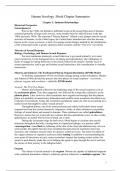Samenvatting
Samenvatting Human Sexuality - Capita Selecta Human Sexology (PSB3E-M20)
- Instelling
- Rijksuniversiteit Groningen (RuG)
- Boek
- Human Sexuality
This summary covers the discussed chapters of the course. The book contains a lot of information and examples, so the most important data has been filtered out for this summary. Since this is a self-study course and there are no lectures, this summary is a bit on the longer side to ensure nothing i...
[Meer zien]





